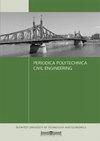骑士裂隙白云石抗盐结晶性评价
IF 1.4
4区 工程技术
Q3 ENGINEERING, CIVIL
引用次数: 0
摘要
本研究旨在评估骑士裂缝城堡碳酸盐石在盐结晶作用下的耐久性。骑士城堡位于叙利亚,被联合国教科文组织列为世界遗产,被认为是12世纪建造的最重要的十字军城堡之一。盐蚀是该建筑石材块体上检测到的一种常见的腐蚀类型,因此在三种不同的盐溶液中对六种不同结构的白云岩岩性进行了盐老化试验;氯化钠,硫酸镁和硫酸钠。其中微生物碎屑岩2种,微晶白云岩4种。微晶白云岩的孔隙度约为28v/v%,而微晶碎屑白云岩的孔隙度较低,分别为18 v/v%和11 v/v%。其中两种微晶白云岩具有双峰孔隙网络,封闭孔隙率约为4 v/v%,而另外两种微晶白云岩的封闭孔隙率非常小(约为0.35 v/v%)。结果表明,尽管开放孔隙度对试样的耐久性影响很大,但封闭孔隙度也起主要作用,其风化形式取决于盐成分和岩石孔隙度特性。在硫酸钠溶液中,试样的主要衰变类型为颗粒状崩解,在氯化钠溶液中形成麻点表面,在硫酸镁溶液中老化后,岩石表面出现薄层剥落现象。NaCl结晶对试样的影响不如硫酸盐的影响大。本文章由计算机程序翻译,如有差异,请以英文原文为准。
Assessment of the Resistance of Dolomite Stone from Crac des Chevaliers Against Salt Crystallization
This study was dedicated to evaluating the durability of the carbonatic stones of Crac des Chevaliers castle against salt crystallization. Crac des Chevaliers castle is a UNESCO world heritage site located in Syria and is considered one of the most important crusader castles built in the 12th century. Salt efflorescence is a common decay type detected on the stone blocks of this building, so six dolomite stone lithotypes with various structures tested under salt aging in three different salt solutions; sodium chloride, magnesium sulfate, and sodium sulfate. Among those lithotypes were two microbioclastic wackstone and four microcrystalline dolomite. The microbioclastic wackstone had low open porosity (18 and 11 v/v%) compared to the microcrystalline dolomites of about 28v/v% open porosity. Two of the microcrystalline dolomite lithotypes had bimodal pore networks and around 4 v/v% closed pores, however, the other two exhibited very small closed porosity (around 0.35 v/v%). The results revealed that even though the great effect of the open porosity on the durability of the specimens, the closed porosity also had a major role and the weathering form depended on the salt composition and the stone porosity properties. The primary decay type of the specimens in sodium sulfate solution was granular disintegration while pitted surfaces formed in sodium chloride solution, and the exfoliation of the stone surface into thin layers was observable after the aging with magnesium sulfate solution. The effect of NaCl crystallization on the specimen was not as aggressive as that of the sulfates.
求助全文
通过发布文献求助,成功后即可免费获取论文全文。
去求助
来源期刊

Periodica Polytechnica-Civil Engineering
工程技术-工程:土木
CiteScore
3.40
自引率
16.70%
发文量
89
审稿时长
12 months
期刊介绍:
Periodica Polytechnica Civil Engineering is a peer reviewed scientific journal published by the Faculty of Civil Engineering of the Budapest University of Technology and Economics. It was founded in 1957. Publication frequency: quarterly.
Periodica Polytechnica Civil Engineering publishes both research and application oriented papers, in the area of civil engineering.
The main scope of the journal is to publish original research articles in the wide field of civil engineering, including geodesy and surveying, construction materials and engineering geology, photogrammetry and geoinformatics, geotechnics, structural engineering, architectural engineering, structural mechanics, highway and railway engineering, hydraulic and water resources engineering, sanitary and environmental engineering, engineering optimisation and history of civil engineering. The journal is abstracted by several international databases, see the main page.
 求助内容:
求助内容: 应助结果提醒方式:
应助结果提醒方式:


